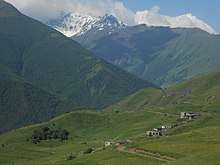Chechens
Chechens (/ˈtʃɛtʃən/; Chechen: нохчий, noxçiy, Old Chechen: нахчой, naxçoy), historically also known as Kisti[17] and Durdzuks[18], are a Northeast Caucasian ethnic group of the Nakh peoples originating in the North Caucasus region primarily in Eastern Europe, located between the Black and Caspian Seas.[19][20] They refer to themselves as Nokhchiy (pronounced [no̞xtʃʼiː]; singular Nokhchi, Nakhchuo or Nakhtche).[21] Chechen and Ingush peoples are collectively known as the Vainakh (which means our people in Chechen) since the 1930s and were known as Nakhchi prior.[22] The majority of Chechens today live in the Chechen Republic, a subdivision of the Russian Federation. Chechens are Muslims.[23]
| Total population | |
|---|---|
| 2 million[1] | |
| Regions with significant populations | |
| 1,431,360[2] | |
| | 1,206,551[3] |
| | 93,658[3] |
| | 18,765[3] |
| | 14,524[3] |
| | 11,980[3] |
| | 11,449[3] |
| | 9,649[3] |
| | 7,229[3] |
| | 6,889[3] |
| 130,000 (2009)[4] | |
| 100,000[5][6] | |
| 32,894[7] | |
| 16,000[8] | |
| 11,000[9] | |
| 10,100 (including Kist people) | |
| 6,000-35,000[10][11] | |
| 5,000[5] | |
| 2,877[12] | |
| 2,000–3,000[13] | |
| 636[14] | |
| 250–1,000[15] Data figures from 2001 to 2013; see also Chechen diaspora.[16] | |
| Languages | |
| Chechen See Language section | |
| Religion | |
| Islam (Shafi'i and Hanafi Sunni Muslims) | |
| Related ethnic groups | |
| Nakh peoples (Ingush people, Kist people, Bats people), Circassians, Northeast Caucasian people, Georgians | |
The isolated terrain of the Caucasus mountains and the strategic value outsiders have placed on the areas settled by Chechens has contributed much to the Chechen community ethos and helped shape its fiercely independent national character. Chechen society has traditionally been egalitarian and organized around many autonomous local clans, called teips.
Etymology
Chechen
According to popular tradition, the Russian term "Chechen" comes from Central Chechnya, which had several important villages and towns named after the word Chechen including, Chechan, Nana-Checha (Mother Checha), and Yokkh Chechen (Greater Chechena).[24] The name "Chechen" occurs in Russian sources in the late 16th century as "Chachana", which is mentioned as a land owned by the Chechen Prince Shikh Murza.[25] The etymology is of Nakh origin and originates from the word "Che"(inside), added with the suffix "cha/chan", which can be translated to "inside territory". The villages and towns named Chechan were always situated in the "Chechan-Are" (Chechen flatlands/plains) located in today's Central Chechnya.[26][27]
Nakhchiy/Nokhchiy
Although "Chechan" (Chechen) was a term used by Chechens to denote a certain geographic area, the Nakh people historically always called themselves "Nakhchiy" (Highland dialects) or "Nokhchiy" (Lowland dialects). The oldest mention of "Nakhchiy" occurred in 1310 by the Georgian Patriach Cyrill Donauri, who mentions the "People of Nakhche" among Tushetians, Avars and many other Northeast Caucasian nations. The term "Nakhchiy" has also been connected to the nation of Nakhchamatyan (mentioned in the 7th century) and Nakhchivan (ancient Armenian city) by many Soviet and modern historians, but the last two hypothesis are greatly criticised. However, Chechen manuscripts in Arabic from the early 1820s mention a certain "Nakhchuvan" (near modern day Kagizman, Turkey) as the homeland of all Nakhchiy. The etymology of the term "Nakhchiy" is believed to be "Nakh" (people) and "Chuo" (territory).[28][29]
Geography and diaspora

The Chechens are mainly inhabitants of Chechnya. There are also significant Chechen populations in other subdivisions of Russia especially in Aukh (part of modern day Dagestan), Ingushetia and Moscow.
Outside Russia, countries with significant diaspora populations are Kazakhstan, Turkey, Azerbaijan, and Arab states (especially Jordan and Iraq): those in Iraq and Jordan are mainly descendants of families who had to leave Chechnya during the Caucasian War, which led to the annexation of Chechnya by the Russian Empire around 1850, while those in Kazakhstan originate from the ethnic cleansing of the entire population carried out by Joseph Stalin and Lavrentiy Beria in 1944. Tens of thousands of Chechen refugees settled in the European Union and elsewhere as the result of the recent Chechen Wars, especially in the wave of emigration to the West after 2002.[30]
History
Origin
Chechens are a Nakh people, and discussion of their origins is intertwined with the discussion of the mysterious origins of Nakh peoples as a whole. The only three surviving Nakh peoples are Chechens, Ingush and Bats, but they are thought by some scholars to be the remnants of what was once a larger family of peoples.
The Nakh languages are a subgroup of Northeast Caucasian, and as such are related to Nakho-Dagestanian family, including the languages of the Avars, Dargins, Lezghins, Laks, etc. However, this relationship is not a close one: the Nakho-Dagestani family is of comparable or greater time-depth than Indo-European, meaning Chechens are only as linguistically related to Avars or Dargins as the French are to the Russians or Iranians.
Nakh peoples such as Chechens are thought to either be descended from original settlers of the Caucasus (North and/or South)[31][32] or supposedly Nakh-speaking ethnic minorities in the north-eastern regions of the ancient state of Urartu (whose people also spoke a language that was possibly related to the Nakh languages).[33] The two theories are not mutually incompatible, and there has been much evidence that seems to link both of the two together (either by dual origins or the "return" theory, in which the Nakh peoples originally lived in the Caucasus and then returned).
Antiquity
In particular, the Chechens are descended from the Durdzuks, a group well known in the Georgian chronicles (Dourts in the Armenian version). Other groups linked Amjad Jaimoukha traces the name Durdzuk to an ancient city north of Lake Urmia, near Nakhichevan (Nakhichevan is thought to be a Nakh placename by some). Other groups attributed to being the ancestors of the Chechens and Ingush include the Kists (in the Georgian chronicles), Gargareans (from the Nakh root gergara; reported by Strabo to have "returned" from the South Caucasus to the North Caucasus, fleeing the wars in the south) and the Nakhchmateans (Armenian chronicles).
The Chechens are one of the Nakh peoples, who have lived in the highlands of the North Caucasus region since prehistory.[34] There is archeological evidence of historical continuity dating back since 3000 B.C.[35] as well as evidence pointing to their ancestors’ migration from the Fertile Crescent c. 10,000–8,000 B.C.[35]
The North Caucasus has been subject to innumerable invaders since time immemorial. In all of recorded history and inferable prehistory, the Chechens had never initiated battle except in self-defence, fighting fiercely to maintain its independence.[36]
Medieval
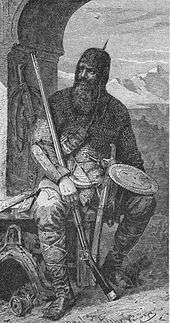
In the Middle Ages, the lowland of Chechnya was dominated by the Khazars and then the Alans. Local culture was also subject to Georgian influence and some Chechens converted to Eastern Orthodox Christianity. With a presence dating back to the seventh century, Islam gradually spread among the Chechens[37] although the Chechens' own pagan religion was still strong until the 19th century. Society was organised along feudal lines. Chechnya was devastated by the Mongol invasions of the 13th century and those of Tamerlane in the 14th.[38][39] The Vainakh bear the distinction of being one of the few peoples to successfully resist the Mongols and defend themselves against their invasions; not once, but twice, though this came at great cost to them, as their state was utterly destroyed. These events were key in the shaping of the Chechen nationhood and their martial-oriented and clan-based society.[40]
Early modern period
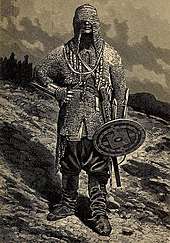
The Caucasus was a major competing area for two neighboring rival empires: the Ottoman and Persian Empires (Safavids, Afsharids, Qajars). Starting from 1555 and decisely from 1639 through the first half of the 19th century, the Caucasus was divided by these two powers, with the Ottomans prevailing in Western Georgia, while Persia kept the bulk of the Caucasus, namely Eastern Georgia, Dagestan, Azerbaijan, and Armenia.[41] The Chechens, however, never really fell under the rule of either empire. As Russia expanded slowly southwards as early as the 16th century, clashes between Chechens and the Russians became more frequent, and it became three empires competing for the region. During these turbulent times the Chechens were organized into semi-independent clans that were loyal to the Mexk-Kela (National Council). The Mehk-Kela was in charge of appointing the Mehk-Da (Ruler of the nation). Several of these appeared during the Late middle ages such as Aldaman Gheza, Tinavin-Visa, Zok-K'ant and others. The administration and military expeditions commanded by Aldaman Gheza during the 1650-1670s led to Chechnya being largely untouched by the major empires of the time. Alliances were concluded with local lords against Persian encroachment and battles were fought to stop Russian influence.[42] As Russia set off to increase its political influence in the Caucasus and the Caspian Sea at the expense of Safavid Persia, Peter I launched the Russo-Persian War (1722-1723), in which Russia succeeded in taking much of the Caucasian territories for several years. Notable in Chechen history, this particular Russo-Persian War marked the first military encounter between Imperial Russia and the Vainakh.[43] Sheikh Mansur led a major Chechen resistance movement in the late 18th century.
In the late 18th and 19th centuries, Russia embarked on full-scale conquest of the North Caucasus in the Caucasian War. Much of the campaign was led by General Yermolov who particularly disliked the Chechens, describing them as "a bold and dangerous people".[44] Angered by Chechen raids, Yermolov resorted to a brutal policy of "scorched earth" and deportations; he also founded the fort of Grozny (now the capital of Chechnya) in 1818. Chechen resistance to Russian rule reached its peak under the leadership of the Dagestani leader Imam Shamil. The Chechens were finally defeated in 1861 after a bloody war that lasted for decades, during which they lost most of their entire population.[45] In the aftermath, large numbers of refugees also emigrated or were forcibly deported to the Ottoman Empire.[46][47][48]
Nineteenth and twentieth centuries

Since then, there have been various Chechen rebellions against Russian/Soviet power in 1865-66, 1877, during the Russian Civil War and World War II, as well as nonviolent resistance to Russification and the Soviet Union's collectivization and anti-religion campaigns. In 1944, all Chechens, together with several other peoples of the Caucasus, were ordered by the Soviet leader Joseph Stalin to be ruthlessly deported en masse to the Kazakh and Kirghiz SSRs; and their republic and nation were abolished. At least one-quarter—and perhaps half—of the entire Chechen population perished in the process, and a severe blow was made to their culture and historical records.[46][49][50] Though "rehabilitated" in 1956 and allowed to return the next year, the survivors lost economic resources and civil rights and, under both Soviet and post-Soviet governments, they have been the objects of both official and unofficial discrimination and discriminatory public discourse.[46][51] Chechen attempts to regain independence in the 1990s after the fall of the Soviet Union have led to the first and the second war with the new Russian state, starting in 1994.
Language
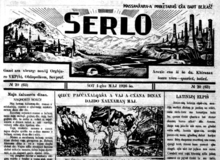
The main language of the Chechen people is Chechen. Chechen belongs to the family of Nakh languages (Northeast Caucasian languages). Literary Chechen is based on the central lowland dialect. Other related languages include Ingush, which has speakers in the neighbouring Ingushetia, and Batsbi, which is the language of the people in the adjoining part of Georgia. At various times in their history, Chechens used Georgian, Arabic and Latin alphabets; as of 2008, the official script is Russian Cyrillic.
Most Chechens living in their homeland can understand Ingush with ease. The two languages are not truly mutually intelligible, but it is easy for Chechens to learn how to understand the Ingush language and vice-versa over time after hearing it for a while.
In 1989, 73.4% spoke Russian,[52] though this figure has declined due to the wars for a large number of reasons (including the lack of proper education, the refusal to learn the language, and the mass dispersal of the Chechen diaspora due to the war). Chechens in the diaspora often speak the language of the country they live in (English, French, German, Arabic, Polish, Georgian, Turkish, etc.).
Genetics
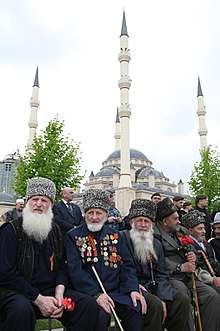
Genetic tests on Chechens, have shown roots mostly in the Caucasus as well as slight connections to and influences from the Middle East as well as Europe. As is the case with many other Caucasian peoples, Chechens are broadly connected with European populations on the Y-DNA (the paternal side) from all European regions, but narrowly closer to Western Europeans in terms of mitochondrial DNA (the maternal side).[53]
A 2004 study of the mtDNA showed Chechens to be diverse in the mitochondrial genome, with 18 different haplogroups out of only 23 samples. This correlates with all other North Caucasian peoples such as the Ingush, Avars and Circassians where the mitochondrial DNA is very diverse.[53][54][55][56][57] They clustered closer to European populations than Middle Eastern populations this time, but were closer to Western European populations (Basques and Britons) than to Eastern European populations (Russians and other Slavs, as well as Estonians), despite living in the East. They actually clustered about as close to Basques as they did to Ingush (Chechens also cluster closer to many other populations than Ingush, such as Abazins), but the Chechens were the closer to the Ingush than any other population, the imbalance probably largely being due to the uniqueness of the Ingush on the mitochondrial DNA among those tested.[53] However the FTDNA groups show that Mitochondrial DNA is very diverse in the North Caucasus in general with Chechens having 12 mtDNA haplogroups out of 108 samples and Ingush 9 out of 15 samples.[58][59]
The most recent study on Chechens, by Balanovsky et al. in 2011[60] sampled a total of 330 Chechens from three sample locations (one in Malgobek, one in Achkhoy-Martan, and one from two sites in Dagestan) and found the following frequencies: A weak majority of Chechens belong to Haplogroup J2 (56.7%[60]), which is associated with Mediterranean, Caucasian and Fertile Crescent populations, with its peaks at 87.4% in Ingushetia and 72% in Georgia's Kazbegi Municipality. In the North Caucasus, the largest frequencies are those of Nakh peoples (Chechens (56.7%) and Ingush (88.8%)).[60] Other notable values were found among North Caucasian Turkic peoples (Kumyks (25%)[61] and Balkars (24%)[62]). It is notable that J2 suddenly collapses as one enters the territory of non-Nakh Northeast Caucasian peoples, dropping to very low values among Dagestani peoples.[53][60][63][64] The overwhelming bulk of Chechen J2 is of the subclade J2a4b* (J2-M67), of which the highest frequencies by far are found among Nakh peoples: Chechens were 55.2% according to the Balanovsky study, while Ingush were 87.4%. Other notable haplogroups that appeared consistently appeared at high frequencies included J1 (20.9%), L (7.0%), G2 (5.5%), R1a (3.9%), Q-M242 (3%) and R1b-M269 (1.8%, but much higher in Chechnya itself as opposed to Dagestani or Ingushetian Chechens). Overall, tests have shown consistently that Chechens are most closely related to Ingush, Circassians and other North Caucasians, occasionally showing a kinship to other peoples in some tests. Balanovsky's study showed the Ingush to be the Chechens' closest relatives by far.[60][64][65]
Chechens are black-, brown-, red- or fair-haired (with darker hair predominating) and eyes can be brown, blue or green, while skin is usually light. George Anchabadze notes that the physical traits of Chechens, which includes being taller than average, are typical of the "Caucasian type" which many other peoples of the Caucasus exhibit.[66][67]
Culture

Prior to the adoption of Islam, the Chechens practiced a unique blend of religious traditions and beliefs. They partook in numerous rites and rituals, many of them pertaining to farming; these included rain rites, a celebration that occurred on the first day of plowing, as well as the Day of the Thunderer Sela and the Day of the Goddess Tusholi. In addition to sparse written record from the Middle Ages, Chechens traditionally remember history through the illesh, a collection of epic poems and stories.
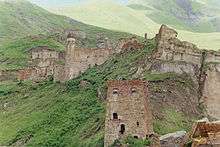
Chechens are accustomed to democratic ways, their social structure being firmly based on equality, pluralism and deference to individuality. Chechen society is structured around tukkhum (unions of clans) and about 130 teip, or clans. The teips are based more on land and one-side lineage than on blood (as exogamy is prevalent and encouraged), and are bonded together to form the Chechen nation. Teips are further subdivided into gar (branches), and gars into nekye (patronymic families). The Chechen social code is called nokhchallah (where Nokhchuo stands for "Chechen") and may be loosely translated as "Chechen character". The Chechen code of honor implies moral and ethical behaviour, generosity and the will to safeguard the honor of women. The traditional Chechen saying goes that the members of Chechen society, like its teips, are (ideally) "free and equal like wolves".[68][69]
Chechens today have a strong sense of nation, which is enforced by the old clan network and nokhchalla – the obligation to clan, tukhum, etc. This is often combined with old values transmuted into a modern sense. They are mythically descended from the epic hero, Turpalo-Nokhchuo ("Chechen Hero"). There is a strong theme of representing the nation with its national animal, the wolf. Due to their strong dependence on the land, its farms and its forests (and indeed, the national equation with the wolf), Chechens have a strong sense of affection for nature. According to Chechen philosopher Apty Bisultanov, ruining an ant-hill or hunting Caucasian goats during their mating season was considered extremely sinful.[70] It is notable that the glasnost era Chechen independence movement, Bart (unity) in fact originated as a simple environmentalist organization in the republic's capital of Grozny.[71]

Chechen culture puts a strong value on the concept of freedom. This asserts itself in a number of ways. A large majority of the nation's national heroes fought for independence (or otherwise, like the legendary Zelimkhan, robbed from the Russian oppressors in order to feed Chechen children in a Robin Hood-like fashion). A common greeting in the Chechen language, marsha oylla, is literally translated as "enter in freedom". The word for freedom also encompasses notions of peace and prosperity.
Chechens are sometimes referred to as the "French of the Caucasus", for a number of reasons (it is notable that the Circassians are the "English of the Caucasus", and the Georgians are the "Italians of the Caucasus"). This comparison may refer to either political/historical traits, or to personality characteristics. Like the French, who overthrew their age-old monarchy in the French Revolution, the Chechens had a similar revolution a century or two earlier,[72] and like the French, they bore the distinction (for a period) of being the only egalitarian society in an area full of monarchic states. Like the French, the Chechens preferred swift, revolutionary (and often violent) methods to realize the change they wished to see – unlike the Circassians (called the "English of the Caucasus" both for their political and personality characteristics) who preferred more gradualist methods.[73] Chechens were also called "French" by early Russian military officers and the French anthropologist Ernest Chantre who noted their "happy and witty" nature.[74]
Religion
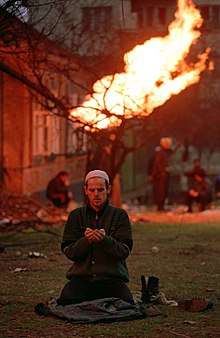
Chechnya is predominantly Muslim.[23] Chechens are overwhelmingly adherents to the Shafi'i Madhhab of Sunni Islam,[75] the republic having converted to Islam between the 16th and the 19th centuries. Most of the population follows either the Shafi'i or the Hanafi,[76] schools of jurisprudence, fiqh. The Shafi'i school of jurisprudence has a long tradition among the Chechens,[77] and thus it remains the most practiced.[78] Some adhere to the mystical Sufi tradition of muridism, while about half of Chechens belong to Sufi brotherhoods, or tariqah. The two Sufi tariqas that spread in the North Caucasus were the Naqshbandiya and the Qadiriya (the Naqshbandiya is particularly strong in Dagestan and eastern Chechnya, whereas the Qadiriya has most of its adherents in the rest of Chechnya and Ingushetia).
A stereotype of an average Chechen being a fundamentalist Muslim is incorrect and misleading.[79][80] By the late 2000s, however, two new trends have emerged in Chechnya. A radicalized remnant of the armed Chechen separatist movement has become dominated by Salafis (popularly known in Russia as Wahhabis and present in Chechnya in small numbers since the 1990s), mostly abandoning nationalism in favor of Pan-Islamism and merging with several other regional Islamic insurgencies to form the Caucasus Emirate. At the same time, Chechnya under Moscow-backed authoritarian rule of Ramzan Kadyrov has undergone its own controversial counter-campaign of Islamization of the republic, with the local government actively promoting and enforcing their own version of a so-called "traditional Islam", including introducing elements of Sharia that replaced Russian official laws.[81][82][83][84]
See also
References
- "Chechnya 'has no troops in Ukraine'". Bbc.com. 28 May 2014. Retrieved 17 October 2018 – via www.bbc.com.
- Russian Census 2010: Population by ethnicity Archived April 24, 2012, at the Wayback Machine (in Russian)
- Russian Census of 2002 Archived October 6, 2014, at the Wayback Machine (in Russian)
- As Hit Men Strike, Concern Grows Among Chechen Exiles, RFE/RL, March 12, 2009
- Chechens in the Middle East: Between Original and Host Cultures Archived 2011-07-22 at the Wayback Machine, Event Report, Caspian Studies Program
- Kristiina Markkanen: Chechen refugee came to Finland via Baku and Istanbul Archived 2011-11-21 at the Wayback Machine (Englisch)
- "Kazakhstan population stats". 2017-01-01. Retrieved 2018-03-03.
- "Jordan willing to assist Chechnya – King". Reliefweb.int. 2007-08-28. Retrieved 2013-04-20.
- Ahmet Katav; Bilgay Duman (November 2012). "Iraqi Circassians (Chechens, Dagestanis, Adyghes)" (PDF). ORSAM Reports (134). Archived from the original (PDF) on 3 April 2013. Retrieved 15 April 2013.
- Jaimoukha, Amjad M. (2008), "Syria", The Chechens: A Handbook, Routledge, p. 232, ISBN 978-0415323284
- "Circassian, Ossetian, Chechen Minorities Solicit Russian Help To Leave Syria". Rferl.org. Retrieved 2013-04-20.
- "About number and composition population of Ukraine by data All-Ukrainian census of the population 2001". Ukraine Census 2001. State Statistics Committee of Ukraine. Retrieved 17 January 2012.
- Chechnya's Exodus to Europe, North Caucasus Weekly Volume: 9 Issue: 3, The Jamestown Foundation, January 24, 2008
- "031 -- Language by sex, by region and municipality in 1990 to 2017". Statistics Finland. Archived from the original on 2018-06-26. Retrieved 2018-08-26.
- Andrew Meier (April 19, 2013). "The Chechens in America: Why They're Here and Who They Are". The Daily Beast. Retrieved April 30, 2013.
- Note that the actual amount of Chechens living in the United States is higher, as they are categorized as Russians in censuses.
- Jaimoukha, Amjad. The Chechens.
- Jaimoukha, Amjad. The Chechens.
- National Geographic Atlas of the World (7th ed.). Washington, DC: National Geographic. 1999. ISBN 978-0-7922-7528-2. "Europe" (pp. 68–69); "Asia" (pp. 90–91): "A commonly accepted division between Asia and Europe ... is formed by the Ural Mountains, Ural River, Caspian Sea, Caucasus Mountains, and the Black Sea with its outlets, the Bosporus and Dardanelles."
- "European Cannibal in Chechnya". 27 October 2018.
- Chisholm, Hugh, ed. (1911). . Encyclopædia Britannica. 6 (11th ed.). Cambridge University Press. p. 21.
- Шнирельман, В. А. Быть аланами. Интеллектуалы и политика на Северном Кавказе в XX веке. — М.: Новое литературное обозрение. p. 279.
- "The George Washington University - Washington, D.C." (PDF). Gwu.edu. Retrieved 17 October 2018.
- https://proza.ru/2020/04/28/198?fbclid=IwAR18x7mDzQ5mvEL9rKIJu19IbgsPLd_Y9y_avKjhatXsIjNsMQf7zZwpblU
- http://orsthoy.ru/images/knigi/%D0%B4%D0%B5%D0%BA%D0%BB%D0%B0%D1%80%D0%B0%D1%86%D0%B8%D1%8F0003.pdf
- http://drevlit.ru/docs/kavkaz/XVI/Russ_Chech_otn/21-40/35.php
- http://ignorik.ru/docs/vajnahi-i-alani-ruslan-arsanukaev-o-proishojdenii-nazvanij.html
- http://ignorik.ru/docs/vajnahi-i-alani-ruslan-arsanukaev-o-proishojdenii-nazvanij.html
- https://chechenlaw.ru/?p=817
- Chechnya's Exodus to Europe, North Caucasus Weekly Volume: 9 Issue: 3, The Jamestown Foundation, January 24, 2008
- Bernice Wuethrich (19 May 2000). "Peering Into the Past, With Words". Science. 288 (5469): 1158. doi:10.1126/science.288.5469.1158.
- Johanna Nichols (February 1997). "The Ingush (with notes on the Chechen): Background information". University of California, Berkeley. Archived from the original on March 11, 2008. Retrieved 2007-02-10.
- Jaimoukha. Chechens. Page 29.
- "ETHNICITY AND CONFLICT IN THE CAUCASUS(5)". Src-h.slav.hokudai.ac.jp. Retrieved 17 October 2018.
- Wuethrich, Bernice (19 May 2000). "Peering Into the Past, With Words". Science. 288 (5469): 1158. doi:10.1126/science.288.5469.1158.
- Jaimoukha pp. 24–25
- Skutsch, Carl, ed. (2005). Encyclopedia of the World's Minorities. New York: Routledge. p. 280. ISBN 1-57958-468-3.
- Jaimoukha pp. 33–34
- Dunlop p.3
- Minahan, James (2000). One Europe, Many Nations: A Historical Dictionary of European National Groups. Greenwood Publishing Group. p. 168. ISBN 978-0-313-30984-7.
- Peimani, Hooman (17 October 2018). Conflict and Security in Central Asia and the Caucasus. ABC-CLIO. ISBN 9781598840544. Retrieved 17 October 2018 – via Google Books.
- https://proza.ru/2019/12/30/99
- Schaefer, Robert W. (2010). The Insurgency in Chechnya and the North Caucasus: From Gazavat to Jihad. ISBN 9780313386343. Retrieved 25 December 2014.
- Dunlop p.14
- Jaimoukha (p.50): "The Chechens suffered horrific losses in human life during the long war. From an estimated population of over a million in the 1840s, there were only 140,000 Chechens left in the Caucasus in 1861..."
- "Who are the Chechens?" (PDF). Archived from the original (PDF) on 2006-09-15. by Johanna Nichols, University of California, Berkeley.
- Dunlop p.29ff. Dunlop writes (p.30): "In 1860, according to Soviet-era figures, 81,360 Chechens left for Turkey; a second emigration took place in 1865, when an additional 22,500 Chechens left. More than 100,000 Chechens were thus ethnically 'cleansed' during this process. This was perhaps a majority of their total population..."
- Jaimoukha p.50
- Jaimoukha p.58
- Dunlop, Chapter 2 "Soviet Genocide", particularly pp. 70–71 ("How many died?")
- Jaimoukha p.60
- Mikhailov, Valentin. Chechnya and Tatarstan
- I. Nasidze, E. Y. S. Ling, D. Quinque et al., "Mitochondrial DNA and Y-Chromosome Variation in the Caucasus Archived 2011-06-08 at the Wayback Machine," Annals of Human Genetics (2004) 68,205–221.
- https://www.researchgate.net/publication/8525622_Mitochondrial_DNA_and_Y-Chromosome_Variation_in_the_Caucasus
- https://www.familytreedna.com/public/ingush?iframe=mtresults
- https://www.familytreedna.com/public/AWAR-MAARULDNA?iframe=mtresults
- https://www.familytreedna.com/public/UbykhSochi?iframe=mtresults
- https://www.familytreedna.com/public/Chechen-Noahcho?iframe=mtresults
- https://www.familytreedna.com/public/ingush?iframe=mtresults
- Oleg Balanovsky et al., "Parallel Evolution of Genes and Languages in the Caucasus Region," Molecular Biology and Evolution 2011
- Yunusbaev 2006
- Battaglia, Vincenza; Fornarino, Simona; Al-Zahery, Nadia; Olivieri, Anna; Pala, Maria; Myres, Natalie M; King, Roy J; Rootsi, Siiri; Marjanovic, Damir (24 December 2008). "Y-chromosomal evidence of the cultural diffusion of agriculture in southeast Europe" (PDF). European Journal of Human Genetics. 17 (6): 820–830. doi:10.1038/ejhg.2008.249. PMC 2947100. PMID 19107149.
- Yunusbaev 2006.
- Caciagli et al, 2009. The key role of patrilineal inheritance in the genetic variation of Dagestani highlanders.
- Nasidze et al. "Mitochondrial DNA and Y-Chromosome Variation in the Caucasus", Annals of Human Genetics (2004)
- Anchabadze, George (2001). The Vainakhs (PDF). Tbilisi: Caucasian House. p. 8. Archived from the original (PDF) on 2012-02-25.
- Чеченцы // Энциклопедический словарь Брокгауза и Ефрона: В 86 томах (82 т. и 4 доп.). – СПб., 1890–1907.
- Jaimoukha. Chechens. Page 83
- Gammer, Moshe. The Lone Wolf and the Bear: Three Centuries of Chechen Defiance of Russian Rule. London 2006. Page 4
- "Chechen Republic – History – Born to be free". Chechen.8m.com. Archived from the original on 2013-05-18. Retrieved 2013-04-20.
- Wood, Tony. Chechnya: The Case for Independence. Page 46
- Jaimoukha, Amjad. ‘’The Chechens: A Handbook’’. Page 14
- Manning, Paul. Just Like England: On the Liberal Institutions of the Circassians Circassianworld.com
- Carlotta Gall and Thomas de Wall. Chechnya: Calamity in the Caucasus. Page 22
- http://www.gwu.edu/~ieresgwu/assets/docs/ponars/pm_0388.pdf
- McDermott, Roger. "Shafi'i and Hanafi schools of jurisprudence in Cechnya". Jamestown.org. Retrieved 2013-04-19.
- Balzer, Marjorie Mandelstam (2009-11-09). Religion and Politics in Russia: A Reader. ISBN 9780765629319.
- Mairbek Vatchagaev (September 8, 2006). "The Kremlin's War on Islamic Education in the North Caucasus". Archived from the original on 2007-10-11. Chechnya Weekly, Volume 7, Issue 34 (September 8, 2006)
- "Shattering the Al Qaeda-Chechen Myth: Part 1". Archived from the original on 2004-01-29., by Brian Glyn Williams, The Jamestown Foundation, October 2, 2003
- Wood, Tony. Chechnya: the Case for Independence. pp. 127–145.
- United Nations High Commissioner for Refugees. "Kadyrov Exploits Ties with Moscow to Build Islamic State". Refworld.org (UNHCR). Retrieved 2013-04-22.
- "Virtue Campaign on Women in Chechnya under Ramzan Kadyrov | Human Rights Watch". Hrw.org. 2012-10-29. Retrieved 2013-04-22.
- "Chechen Leader's Islamic Policies Stir Unease". Npr.org. Retrieved 2013-04-22.
- Tom Parfitt, Grozny, Russia (16 March 2011). "The Islamic Republic of Chechnya". Pulitzer Center. Retrieved 2013-04-22.CS1 maint: multiple names: authors list (link)
Sources
- Amjad Jaimoukha, The Chechens: A Handbook (London, New York: Routledge, 2005)
- Lechi Ilyasov, The Diversity of the Chechen Culture: From Historical Roots to the Present (Moscow, 2009)
- John B. Dunlop, Russia Confronts Chechnya: Roots of a Separatist Conflict (Cambridge University Press, 1998)
